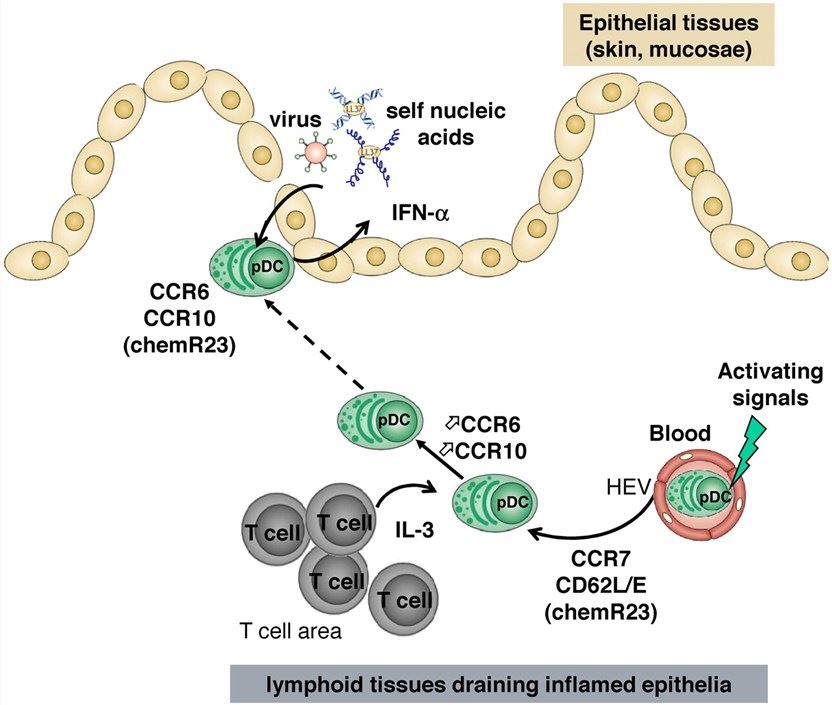ACKR2 gene encodes atypical chemokine receptor 2, which is predicted to be a seven transmembrane protein. This gene is mapped to chromosome 3p21.3, a region that includes a cluster of chemokine receptor genes. ACKR2 is the best-characterized member of the subfamily of chemokine receptors that are referred to as ACRs because of their inability to induce directional cell migration, in contrast to conventional chemokine receptors. ACKR2 is expressed in several different tissues, most prominently on lymphatic endothelial cells in lung and skin, and on syncytiotrophoblast cells in the placenta. This receptor appears to bind to most members of the family of beta-chemokines. However, its specific function is still unknown.
| Basic Information of ACKR2 | |
| Protein Name | Atypical chemokine receptor 2 |
| Gene Name | ACKR2, CCBP2, CCR10, CMKBR9, D6 |
| Aliases | C-C chemokine receptor D6, Chemokine receptor CCR-10, Chemokine receptor CCR-9, Chemokine-binding protein 2, Chemokine-binding protein D6 |
| Organism | Homo sapiens (Human) |
| UniProt ID | O00590 |
| Transmembrane Times | 7 |
| Length (aa) | 384 |
| Sequence | MAATASPQPLATEDADSENSSFYYYDYLDEVAFMLCRKDAVVSFGKVFLPVFYSLIFVLGLSGNLLLLMVLLRYVPRRRMVEIYLLNLAISNLLFLVTLPFWGISVAWHWVFGSFLCKMVSTLYTINFYSGIFFISCMSLDKYLEIVHAQPYHRLRTRAKSLLLATIVWAVSLAVSIPDMVFVQTHENPKGVWNCHADFGGHGTIWKLFLRFQQNLLGFLLPLLAMIFFYSRIGCVLVRLRPAGQGRALKIAAALVVAFFVLWFPYNLTLFLHTLLDLQVFGNCEVSQHLDYALQVTESIAFLHCCFSPILYAFSSHRFRQYLKAFLAAVLGWHLAPGTAQASLSSCSESSILTAQEEMTGMNDLGERQSENYPNKEDVGNKSA |
As a chemokine decoy receptor, ACKR2 can bind and internalize chemokines without activating an intracellular response. ACKR2 binds most inflammatory CC-chemokines (CCL2, CCL5, CCL3, etc.) leading to their degradation, thereby reducing local levels of inflammatory chemokines, suggesting ACKR2 maybe a likely modulator of local inflammation. Upon active ligand stimulation, ACKR2 activates a beta-arrestin 1 (ARRB1)-dependent, G protein-independent signaling pathway that results in the phosphorylation of the actin-binding protein cofilin (CFL1) through a RAC1-PAK1-LIMK1 signaling pathway. Activation of this pathway increases its efficiency in chemokine degradation and clearance from the extracellular space. ACKR2 is reported to play a nonredundant role in the protection against fetal loss caused by systemic inflammation and antiphospholipid antibodies by scavenging chemokines on the surfaces of lymphatic vessels and in the placenta. In addition, ACKR2 plays a negative role in the growth and metastasis of breast cancer, indicating its potential as a biomarker of this disease.
 Fig.1 Model for pDC recruitment into inflamed epithelial sites. On their recruitment into lymphoid organs in a manner that involves CCR7 and CD62L, pDCs might be instructed through IL-3 released by local T cells to express CCR6 and CCR10. (Sisirak, 2011)
Fig.1 Model for pDC recruitment into inflamed epithelial sites. On their recruitment into lymphoid organs in a manner that involves CCR7 and CD62L, pDCs might be instructed through IL-3 released by local T cells to express CCR6 and CCR10. (Sisirak, 2011)
This article finds that ACKR2 can regulate T-cell priming and GM-CSF-producing B cells during the induction of arthritic and neuropathic autoimmunity in mice, and its deletion leads to subtle changes in the development of the disease.
This article suggests that primary human trophoblasts use ACKR2 to mediate efficient chemokine scavenging and that Ackr2 can play indispensable roles in regulating the placental structure, fetal weight, and neonatal mortality in mice. ACKR2 is a prominent player in the regulation of placental chemokine networks.
This article suggests that ACKR2 chemokine scavenger receptor has an unexpectedly important role in the development of diabetic kidney disease. Deletion of the ACKR2 gene in OVE diabetic mice produced a great reduction in albuminuria, accompanied by reduced severity of renal fibrosis, leucocyte infiltration, and inflammatory chemokine gene expression.
This article reveals that N-terminal tyrosine residues are essential for ligand internalization and scavenging and demonstrates the ability of a peptide derived from this region to bind inflammatory CC-chemokines.
This article suggests that trout ACKR2 is regulated in a complex way and has an important role in the control of the chemokine network in fish as in mammals.
Membrane protein studies have advanced significantly over the past few years. Based on our versatile Magic™ membrane protein production platform, we could offer a series of membrane protein preparation services for worldwide customers in reconstitution forms as well as multiple active formats. Aided by our versatile Magic™ anti-membrane protein antibody discovery platform, we also provide customized anti-ACKR2 antibody development services.
During the past years, Creative Biolabs has successfully generated many functional membrane proteins for our global customers. We are happy to accelerate the development of our clients’ programs with our one-stop, custom-oriented service. For more detailed information, please feel free to contact us.
Reference
All listed services and products are For Research Use Only. Do Not use in any diagnostic or therapeutic applications.